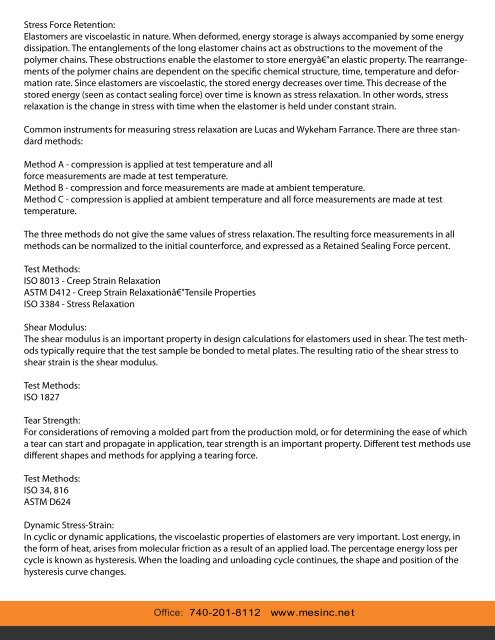ASTM D2000 - Elastomer and Rubber Material Selection Guide
ASTM D2000 - Elastomer and Rubber Material Selection Guide
ASTM D2000 - Elastomer and Rubber Material Selection Guide
Create successful ePaper yourself
Turn your PDF publications into a flip-book with our unique Google optimized e-Paper software.
Stress Force Retention:<br />
<strong>Elastomer</strong>s are viscoelastic in nature. When deformed, energy storage is always accompanied by some energy<br />
dissipation. The entanglements of the long elastomer chains act as obstructions to the movement of the<br />
polymer chains. These obstructions enable the elastomer to store energyâ€"an elastic property. The rearrangements<br />
of the polymer chains are dependent on the speci�c chemical structure, time, temperature <strong>and</strong> deformation<br />
rate. Since elastomers are viscoelastic, the stored energy decreases over time. This decrease of the<br />
stored energy (seen as contact sealing force) over time is known as stress relaxation. In other words, stress<br />
relaxation is the change in stress with time when the elastomer is held under constant strain.<br />
Common instruments for measuring stress relaxation are Lucas <strong>and</strong> Wykeham Farrance. There are three st<strong>and</strong>ard<br />
methods:<br />
Method A - compression is applied at test temperature <strong>and</strong> all<br />
force measurements are made at test temperature.<br />
Method B - compression <strong>and</strong> force measurements are made at ambient temperature.<br />
Method C - compression is applied at ambient temperature <strong>and</strong> all force measurements are made at test<br />
temperature.<br />
The three methods do not give the same values of stress relaxation. The resulting force measurements in all<br />
methods can be normalized to the initial counterforce, <strong>and</strong> expressed as a Retained Sealing Force percent.<br />
Test Methods:<br />
ISO 8013 - Creep Strain Relaxation<br />
<strong>ASTM</strong> D412 - Creep Strain Relaxationâ€"Tensile Properties<br />
ISO 3384 - Stress Relaxation<br />
Shear Modulus:<br />
The shear modulus is an important property in design calculations for elastomers used in shear. The test methods<br />
typically require that the test sample be bonded to metal plates. The resulting ratio of the shear stress to<br />
shear strain is the shear modulus.<br />
Test Methods:<br />
ISO 1827<br />
Tear Strength:<br />
For considerations of removing a molded part from the production mold, or for determining the ease of which<br />
a tear can start <strong>and</strong> propagate in application, tear strength is an important property. Di�erent test methods use<br />
di�erent shapes <strong>and</strong> methods for applying a tearing force.<br />
Test Methods:<br />
ISO 34, 816<br />
<strong>ASTM</strong> D624<br />
Dynamic Stress-Strain:<br />
In cyclic or dynamic applications, the viscoelastic properties of elastomers are very important. Lost energy, in<br />
the form of heat, arises from molecular friction as a result of an applied load. The percentage energy loss per<br />
cycle is known as hysteresis. When the loading <strong>and</strong> unloading cycle continues, the shape <strong>and</strong> position of the<br />
hysteresis curve changes.<br />
Office: 740-201-8112 www.mesinc.net


